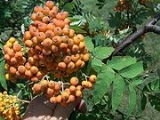
Sorbus americana
Encyclopedia
The tree species Sorbus americana (syn. Pyrus americana) is commonly known as the American Mountain-ash. It is a relatively small (height 12 meters / 40 feet) deciduous perennial tree, native to eastern northern North America.
The American mountain-ash and related species (most often the European Mountain ash, Sorbus aucuparia
) are also referred to as rowan trees.
and Lake Superior
.
It resembles the European Mountain-ash, Sorbus aucuparia
.
Eastern Canada:
Canada - New Brunswick, Newfoundland, Nova Scotia, Ontario, Prince Edward Island, Quebec
Northeastern U.S.A.: United States - Connecticut, Indiana, Maine, Massachusetts, Michigan, New Hampshire, New York, Pennsylvania, Vermont, West Virginia
North-Central U.S.A.: United States - Illinois [n. (Ogle Co.)], Minnesota, Wisconsin
Southeastern U.S.A.: United States - Georgia, Maryland, North Carolina, Tennessee, Virginia
Sorbus americana is listed as endangered by the State of Illinois
.
birds and small mammals, including ruffed grouse, ptarmigans,
sharp-tailed grouse, blue grouse, American robins, other thrushes,
waxwings, jays, squirrels, and rodents.
American mountain-ash is a preferred browse for moose and white-tailed
deer. Moose will eat foliage, twigs, and bark. Up to 80
percent of American mountain-ash stems were browsed by moose in control
plots adjacent to exclosures on Isle Royale. Fishers, martens,
snowshoe hares, and ruffed grouse also browse American mountain-ash.
http://www.fs.fed.us/database/feis/plants/tree/sorame/all.html
The American mountain-ash and related species (most often the European Mountain ash, Sorbus aucuparia
Sorbus aucuparia
Sorbus aucuparia , is a species of the genus Sorbus, native to most of Europe except for the far south, and northern Asia...
) are also referred to as rowan trees.
Description
The American Mountain-ash attains its largest specimens on the northern shores of Lake HuronLake Huron
Lake Huron is one of the five Great Lakes of North America. Hydrologically, it comprises the larger portion of Lake Michigan-Huron. It is bounded on the east by the Canadian province of Ontario and on the west by the state of Michigan in the United States...
and Lake Superior
Lake Superior
Lake Superior is the largest of the five traditionally-demarcated Great Lakes of North America. It is bounded to the north by the Canadian province of Ontario and the U.S. state of Minnesota, and to the south by the U.S. states of Wisconsin and Michigan. It is the largest freshwater lake in the...
.
It resembles the European Mountain-ash, Sorbus aucuparia
Sorbus aucuparia
Sorbus aucuparia , is a species of the genus Sorbus, native to most of Europe except for the far south, and northern Asia...
.
- Bark: Light gray, smooth, surface scaly. Branchlets downy at first, later become smooth, brown tinged with red, lenticular, finally they become darker and the papery outer layer becomes easily separable.
- Wood: Pale brown; light, soft, close-grained but weak. Sp. gr., 0.5451; weight of cu. ft., 33.97 lbs.
- Winter buds: Dark red, acute, one-fourth to three-quarters of an inch long. Inner scales are very tomentose and enlarge with the growing shoot.
- Leaves: (see Leaf shapeLeaf shapeIn botany, leaf shape is characterised with the following terms :* Acicular : Slender and pointed, needle-like* Acuminate : Tapering to a long point...
for explanation of terms) Alternate, compound, odd-pinnate, six to ten inches long, with slender, grooved, dark green or red petiole. Leaflets thirteen to seventeen, lanceolate or long oval, two to three inches long, one-half to two-thirds broad, unequally wedge-shaped or rounded at base, serrate, acuminate, sessile, the terminal one sometimes borne on a stalk half an inch long, feather-veined, midrib prominent beneath, grooved above. They come out of the bud downy, conduplicate; when full grown are smooth, dark yellow green above and paler beneath. In autumn they turn a clear yellow. Stipules leaf-like, caducous. - Flowers: May, June, after the leaves are full grown. Perfect, white, one-eighth of an inch across, borne in flat compound cymes three or four inches across. Bracts and bractlets acute, minute, caducous.
- Calyx: Urn-shaped, hairy, five-lobed; lobes, short, acute, imbricate in bud.
- Corolla: Petals five, creamy white, orbicular, contracted into short claws, inserted on calyx, imbricate in bud.
- Stamens: Twenty to thirty, inserted on calyx tube; filaments thread-like; anthers introrse, two-celled; cells opening longitudinally.
- Pistil: Two to three carpels inserted in the bottom of the calyx tube and united into an inferior ovary. Styles two to three; stigmas capitate; ovules two in each cell.
- Fruit: Berry-like pome, globular, one-quarter of an inch across, bright red, borne in cymous clusters. Ripens in October and remains on the tree all winter. Flesh thin and sour, charged with malic acid; seeds light brown, oblong, compressed; cotyledons fleshy.
Distribution
Native to northern North America;Eastern Canada:
Canada - New Brunswick, Newfoundland, Nova Scotia, Ontario, Prince Edward Island, Quebec
Northeastern U.S.A.: United States - Connecticut, Indiana, Maine, Massachusetts, Michigan, New Hampshire, New York, Pennsylvania, Vermont, West Virginia
North-Central U.S.A.: United States - Illinois [n. (Ogle Co.)], Minnesota, Wisconsin
Southeastern U.S.A.: United States - Georgia, Maryland, North Carolina, Tennessee, Virginia
Sorbus americana is listed as endangered by the State of Illinois
Illinois
Illinois is the fifth-most populous state of the United States of America, and is often noted for being a microcosm of the entire country. With Chicago in the northeast, small industrial cities and great agricultural productivity in central and northern Illinois, and natural resources like coal,...
.
Ecological aspects
The berries of American mountain-ash are eaten by numerous species ofbirds and small mammals, including ruffed grouse, ptarmigans,
sharp-tailed grouse, blue grouse, American robins, other thrushes,
waxwings, jays, squirrels, and rodents.
American mountain-ash is a preferred browse for moose and white-tailed
deer. Moose will eat foliage, twigs, and bark. Up to 80
percent of American mountain-ash stems were browsed by moose in control
plots adjacent to exclosures on Isle Royale. Fishers, martens,
snowshoe hares, and ruffed grouse also browse American mountain-ash.
http://www.fs.fed.us/database/feis/plants/tree/sorame/all.html
Cultivation
Prefers a rich moist soil and the borders of swamps, but will flourish on rocky hillsides.External links
- Sorbus americana - picture of young tree, and complete summary data
- Interactive Distribution Map for Sorbus americana
- distribution map

